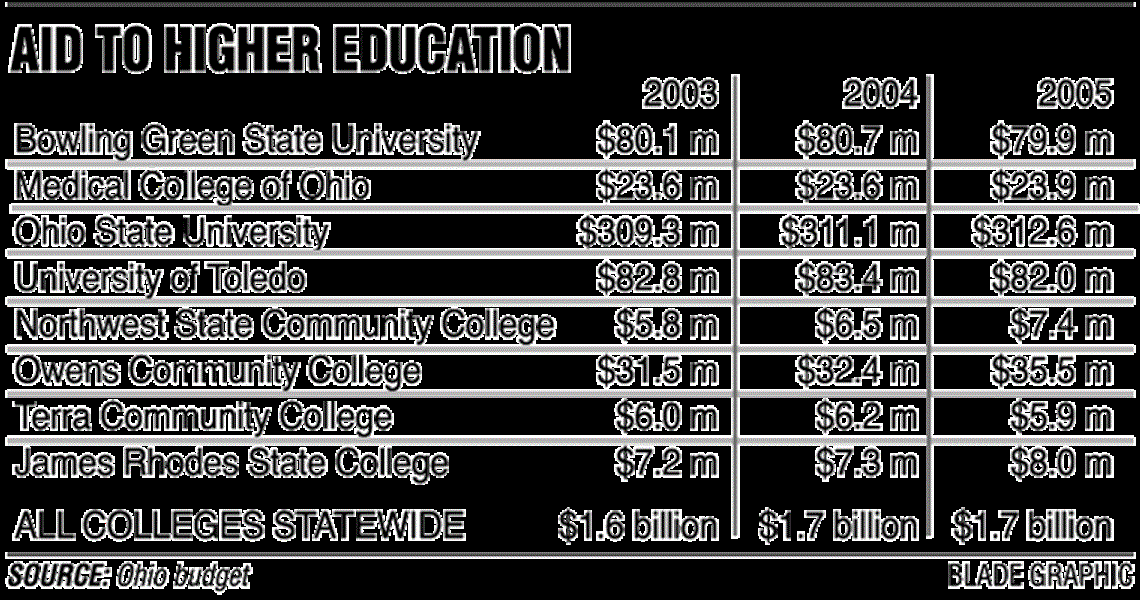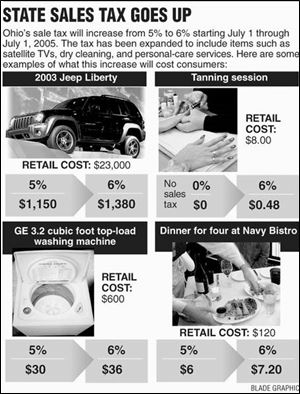
$49 billion plan for Ohio spending takes form
6/20/2003

COLUMBUS - The Ohio General Assembly was poised early today to consider a $49 billion, two-year budget that will tap consumers' wallets and corporate coffers to fuel additional spending on K-12 education, colleges, and Medicaid.
A House-Senate conference committee worked more than 11 hours through Wednesday night into yesterday morning on a plan boosting state spending more than 10 percent, relying chiefly on a “temporary” penny-on-the-dollar sales-tax surcharge and a one-time financial windfall from the federal government to pay for it.
The two Democrats on the six-member committee voted against the final plan, but House Minority Leader Chris Redfern (D., Catawba Island) said he anticipated about six Democrats would join Republicans to support the deal.
That would be enough to put House Speaker Larry Householder (R., Glenford) over the top, he said.

Senate Democrats reported as many as six members will give the GOP their votes.
Mr. Redfern won't be among the “yes” votes.
“The reliance on sales taxes is too great,” he said. “I support business loophole closings. I don't believe middle-income families should have to carry this burden solely.”
He predicted the legislature will have to amend the budget late this year because revenue will continue to slump as spending increases.
“I would not be surprised if there's a Christmas package under the tree that we don't want to open,” he said.
The budget must be in place before the end of the current fiscal year on June 30, but lawmakers are rushing to get the plan to Gov. Bob Taft this week to give the state and merchants time to adjust for the increase in the sales tax. The state's share of the tax would climb to 6 cents through June 30, 2005.

Despite concerns raised over the heavy reliance of one-time funds like the sales tax and $578 million in one-time federal funds, state Budget Director Tom Johnson commended the conference committee.
“A particular concern is the temporary sales tax, but they've done several things to position us in a good way in 2006,” he said. “They've started a rainy day [reserve] fund. There's very little one-time revenue. They've left [Ohio's tobacco settlement] alone [in the second year].”
The committee rolled two business-tax proposals from Mr. Taft's Jan. 30 tax “reform” proposal into the plan to help offset a $1.1 billion-plus projected revenue shortfall that the administration surprised lawmakers with last week.
The sales tax would be imposed on WATS and 800-type telecommunications services, but call centers with more than 50 employees would be exempted. The tax increase is expected to generate $131 million over two years.
The other would adopt the “business versus nonbusiness” approach, restricting how much income from a company's subsidiary could be labeled nonbusiness to avoid Ohio taxation. That's expected to raise an additional $58 million over two years.
In addition to raising the sales tax through June 30, 2005, eight services would be added to the tax base, among them satellite TV, dry cleaning, and self-storage. The expansion would take effect on Aug. 1.
The Republican-controlled conference committee clarified that massages would be exempt from the sales tax only if a physician or chiropractor ordered that service as therapy.
An amendment also says those who provide snow removal services would only have to charge sales tax if they were paid more than $5,000 a year. The state Taxation Department said it didn't want to start taxing children or people who help their neighbors in the winter.
The final version of the budget bill would phase out the inventory portion of the tangible personal property tax by two percentage points each year, starting in tax year 2005. School districts and local governments that would lose revenue have protested.
The budget would boost spending in the Department of Education 2.2 percent in 2004 and 2.3 percent in 2005. But those numbers don't rise to the levels sought by Mr. Taft and the Senate.
“The Senate made a strong statement about making education the greatest priority possible in this tough budget, but since the Senate passed its version of the budget, there's been an additional $1.1 billion or so less money available,” said Sen. Randy Gardner (R., Bowling Green).
“Some of that was made up with federal dollars, but it created additional pressures,” he said. “I'm just pleased that this budget still increases funding for both primary and secondary and higher education at a time when it was not easy to achieve.”
The state's higher-education budget would climb less than 1 percent in 2004 followed by 1.5 percent in 2005. The final version of the budget bill would place a 6 percent tuition cap on state-supported universities, except for Ohio State, which would be allowed a 9 percent increase.
But an amendment added early yesterday morning would enable all state-supported universities to tack on an additional 3 percent to 3.9 percent if the money was used for scholarships for low-income students or improved technology for students.
The House-Senate committee also scrapped the House plan to put video gambling machines on the Nov. 4 ballot. The House had proposed letting voters decide whether electronic slot machines should be installed at Ohio's seven horse-racing tracks. If so, the sales-tax rate increase would have been lowered to 5 percent on July 1, 2004.